
The Breed History
This is one of four coat types of the Belgian Shepherd type dog.
This breed originated in the town of Tervuren, Belgium. The other
haircoat types are Malinois, Groenendael, and Laekenois. Their
common ancestor is the Belgian Sheepdog. The Tervuren are the
longhaired, colored other than black variety, though hairs are black
tipped. The Tervuren is considered a later variety that the Malinois,
and may be derived from the Groenendaels since matings of the
latter can produce the Tervuren coat type. Though these coat types
share a single breed standard outside the AKC and America, the
types are split into separate breeds here, with minor distinguishing
characteristics. The first breed standard for the Tervuren was drawn
up in 1893. The AKC registered these dogs first in 1959.
Breeding for Function
Very high intelligence and trainability are a breed hallmark.
Obedience, herding, tracking, sledding, drug detection, and
Schutzhund represent some of their talents. Historically, herding
was their primary purpose, with farm protection running second.
Currently, they serve as service dogs, police and security dogs, and
are widely used in agility trials. Many are also companion dogs.
Physical Characteristics
Height at Withers: female 22-24" (56-61 cm), male 24-26" (61-66 cm).
Weight: Average 62 lb (28 kg).
Coat: The outer coat is long, dense and straight. Hairs are hard but
not wiry. The undercoat is dense and soft. Furnishings are more
developed in males. Facial hair is short. A non-black longhaired
Belgian Shepherd-type dog is the distinguishing characteristic of a
Tervuren. Black masking and a fawn to mahogany base color with
black tipping is the preferred combination, but other non-black
colors are accepted. The dogs tend to get darker with age. A small
white chest patch is accepted.
Longevity: 12-14 years
Points of Conformation: These dogs have a strong constitution,
square in conformation (females may be a bit longer), lithe and
well balanced. Tervurens are solid without being coarse, the head is
long, well chiseled, and the eyes are medium sized, almond-shaped,
and dark brown in color. The ears are stiff, erect and triangular, the
muzzle is pointed, the stop is moderately well defined, and the nose
is black. The neck is long, well muscled, and not throaty. The topline
is level, the thorax deep, and the abdomen moderately tucked up.
The tail is high set and reaches to the tarsus at rest; in action it may
be held horizontal to the topline. Limbs are straight boned, and the
bone is oval in cross section. Dewclaws may be removed in front,
and are usually removed in the rear. Feet are small, compact and
well knuckled up with strong nails. The gait is springy and ground
covering. As for the Malinois, the standard stipulates a preference
to move in a circle over a straight line. This may reflect the herding
heritage of this breed.
Recognized Behavior Issues and Traits
Reported breed characteristics include: Defensive-protective,
devoted (even possessive), courageous, may be snappy, and has
high exercise needs and a high base activity level. Grooming needs
are low, and moderate shedding occurs. They are generally good
with other dogs in the household, and have variable tolerance to
other smaller pets. Not the best choice of dog for a household with
a child; they do best with experienced owners.
Normal Physiologic Variations
Leukopenia: Physiologic leukopenia, resulting from low numbers
of neutrophils, lymphocytes, and monocytes, may be a typical
finding in a large percentage of healthy Belgian Tervuren and is not
of clinical importance in otherwise healthy dogs. Healthy Belgian
Tervuren may also have RBC counts and hematocrits higher than
expected for healthy dogs. In one study of 180 healthy Belgian
Tervuren in the United States, total WBC counts ranged from 2,610
to 16,900. All dogs were otherwise clinically normal. In a study in
Belgium, only 1 of 94 Tervuren was identified with the condition.
Reported at a frequency of 1.3% in the 2003 American Belgian
Tervuren Club Health Survey.
Drug Sensitivities
None reported
Inherited Diseases
Elbow Dysplasia: Polygenically inherited trait causing elbow
arthritis. OFA reports 4.4% affected.
Hip Dysplasia: Polygenically inherited trait causing degenerative
joint disease and hip arthritis. OFA reports 3.6% affected. Reported
at a frequency of 2.2% in the 2003 American Belgian Tervuren Club
Health Survey.
Patella Luxation: Polygenically inherited laxity of patellar
ligaments, causing luxation, lameness, and later degenerative joint
disease. Treat surgically if causing clinical signs. Too few Belgian
Tervurens have been screened by OFA to determine an accurate
frequency.
Disease Predispositions
Idiopathic Epilepsy (Inherited Seizures): Control with anti-seizure
medication. In the Belgian Tervuren, seizures can be partial or
generalized. In the Belgian Tervuren, epilepsy has a high heritability
of 0.77 to 0.83 with a polygenic mode of inheritance, though
influenced by a single autosomal recessive gene of large effect.
Genome-wide linkage scan identifies multiple chromosomal
locations for possible epilepsy liability genes. Epilepsy may afflict as
much as 17% of the breed. Reported in 8.9% of dogs in the 1998
Tervuren Health Survey, and 8.5% in the 2003 American Belgian
Tervuren Club Health Survey. Prevalence of 9.5% in Denmark with
an average age of onset of 3.3 years.
Allergic Dermatitis (Atopy): Inhalant or food allergy. Presents
with pruritis and pyotraumatic dermatitis (hot spots). Reported in
7.3% of dogs in the 1998 Tervuren Health Survey, and 7.3% in the
2003 American Belgian Tervuren Club Health Survey.
Persistent Pupillary Membranes: Strands of fetal remnant
connecting; iris to iris, cornea, lens, or involving sheets of tissue.
The later three forms can impair vision, and dogs affected with
these forms should not be bred. Identified in 6.88% of Belgian
Tervuren CERF examined by veterinary ophthalmologists between
2000-2005. Reported in 2.0% of dogs in the 1998 Tervuren Health
Survey, and 3.8% in the 2003 American Belgian Tervuren Club
Health Survey.
Cryptorchidism: Unilateral or bilateral undescended testicles.
Reported in 5.1% of males in the 1998 Tervuren Health Survey,
and 3.3% in the 2003 American Belgian Tervuren Club Health
Survey. This is a sex-limited disorder with an unknown mode of
inheritance.
Cataracts: Anterior cortex punctate cataracts predominate,
though posterior nuclear and capsular cataracts also occur in the
breed. Identified in 2.44% of Belgian Tervuren CERF examined by
veterinary ophthalmologists between 2000-2005. Reported in
3.4% of dogs in the 1998 Tervuren Health Survey, and 6.2% in the
2003 American Belgian Tervuren Club Health Survey. CERF does not
recommend breeding any Belgian Tervuren with a cataract.
Hypothyroidism: Inherited autoimmune thyroiditis. 3.0% positive
for thyroid auto-antibodies based on testing at Michigan State
University. (Ave. for all breeds is 7.5%). Reported at a frequency of
6.6% in the 2003 American Belgian Tervuren Club Health Survey.
Gastric Carcinoma: Diagnosis by contrast radiographic
examination, endoscopy, and biopsy. Surgery is the only potentially
curative modality for localized gastric carcinoma. Though the
prognosis is poor, prolonged survival times in individual animals are
possible. Reported at a frequency of 1.13% in Tervurens in Holland,
with a mean age of 9.5 years at diagnosis. Computed heritability
was 0.09 with a male predominance.
Optic Nerve Hypoplasia/Micropapilla: Congenital defect of optic
nerve development affecting vision, or a small optic disc. Identified
in 1.05% of Belgian Tervuren CERF examined by veterinary
ophthalmologists between 2000-2005.
Demodicosis: Demodectic mange has an underlying immunodeficiency
in its pathogenesis. Reported in 2.1% of dogs in the 1998
Tervuren Health Survey, and 2.7% in the 2003 American Belgian
Tervuren Club Health Survey.
Cancer: Mammary (breast) cancer is reported at a frequency
of 1.6%, Lymphoma 1.3%, and Osteosarcoma 1.3% in the 2003
American Belgian Tervuren Club Health Survey.
Vitiligo: Pigment loss most commonly affecting the face and
mouth in young adult Belgian Tervurens is due to a regression
of melanocytes in the epidermis. Although there is partial
repigmentation in some dogs, complete repigmentation does not
occur. Unknown mode of inheritance.
Retinal Dysplasia: Focal folds and geographic retinal dysplasia
are seen in the breed. Dogs with the geographic form should not
be bred. Identified in 0.58% of Belgian Tervuren CERF examined by
veterinary ophthalmologists between 2000-2005.
Chronic Superficial Keratitis (Pannus): Belgian Tervuren dogs are
more predisposed toward this condition than other breeds. It can
cause vision problems due to corneal pigmentation. Age of onset
2-5 years. Treatment with topical ocular lubricants and anti-inflammatory
medication. Identified in 0.56% of Belgian Tervuren CERF
examined by veterinary ophthalmologists between 2000-2005. CERF
does not recommend breeding any affected Belgian Tervuren.
Progressive Retinal Atrophy (PRA): Progressive degeneration of
the retina, eventually causing blindness. Age of onset 4-5 years.
Reported to occur at a low frequency in the breed. CERF does not
recommend breeding any Belgian Tervuren with PRA. Mode of
inheritance presumed to be autosomal recessive.
Anasarca, Anterior Crossbite, Atrial Septal Defect, Level Bite,
Lymphedema, Oligodontia, Prognathism, and Wry Mouth are
reported.
Isolated Case Studies
None reported
Genetic Tests
Tests of Genotype: Direct tests are available for presence of
black-and-tan and sable coat colors from HealthGene and VedtGen.
Tests of Phenotype: CHIC Certification: Required testing
includes hip and elbow radiographs, CERF eye examination, and
thyroid profile including autoantibodies. (See CHIC website; www.
caninehealthinfo.org).
Recommend patella evaluation and cardiac evaluation.
Miscellaneous
- Breed name synonyms: Chien de Berger Belge, Tervueren, Terve,
Belgian Sheepdog, Belgian Shepherd.
- Registries: AKC, UKC (under Belgian Shepherd), CKC, KCGB
(Kennel Club of Great Britain), under Belgian Shepherd, ANKC
(Australian National Kennel Club), under Belgian Shepherd, NKC
(National Kennel Club), under Belgian Shepherd.
- AKC rank (year 2008): 103 (452 dogs registered)
Internet resources: American Belgian Tervuren Club Inc.:
www.abtc.org
Belgian Shepherd Dog Club of Canada: www.bsdcc.org
Belgian Shepherd Dog Association of Great Britain:
www.bsdaofgb.co.uk
Photo Gallery of Breed - Belgian Tervuren - Dog Breed
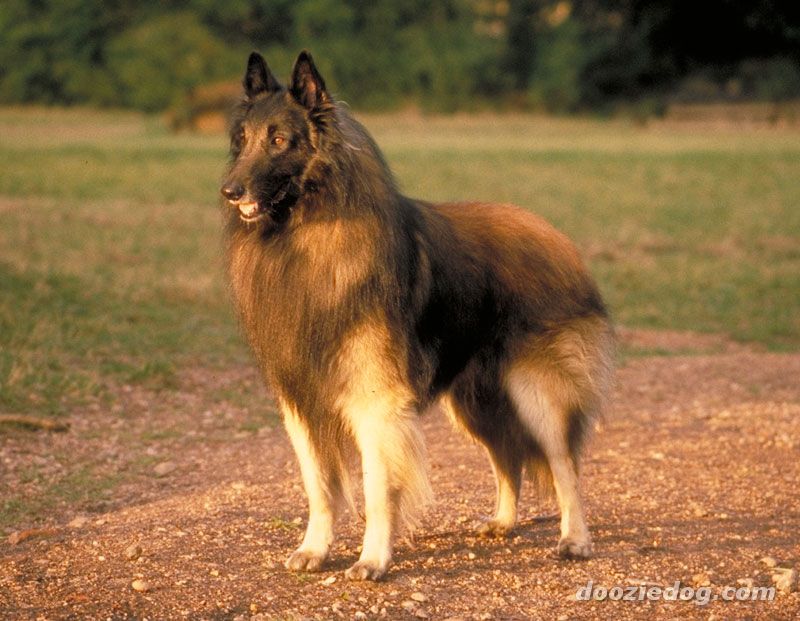

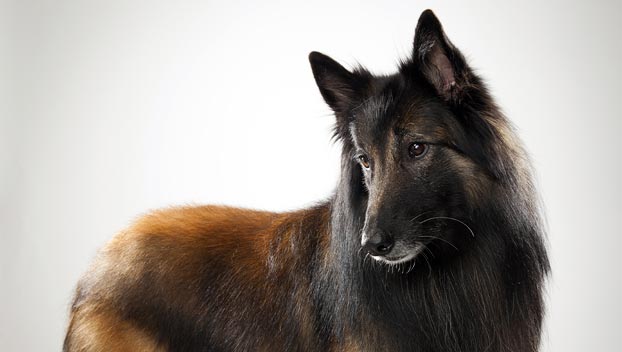
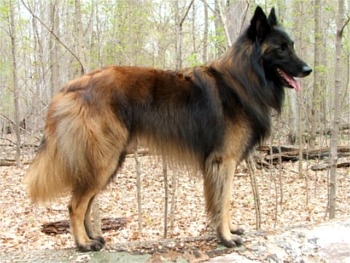
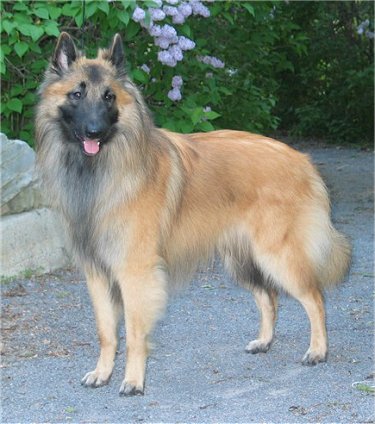


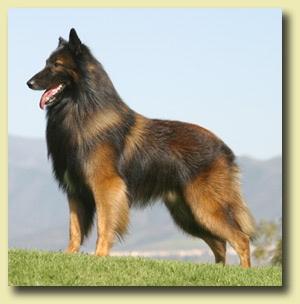
 Animalia Life
Animalia Life